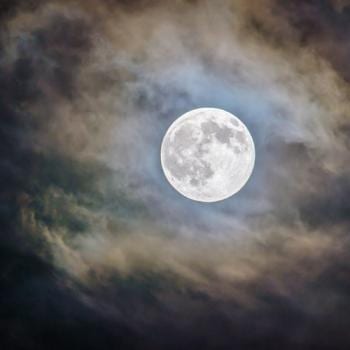The Stang is adored by many modern Traditional Witches, myself included. It’s a tool whose use powerfully evokes a sense of connection to something old and primitive. In its simplest form, a forked staff, Witches use the Stang in various ways including representing the Horned One, aiding in spirit flight, and directing energy.
When I first found Traditional Witchcraft, I often wondered where exactly this instrument of Arte came from. With the Athame in Wicca, we can, with some certainty, trace its origins. So I began to wonder, if we could do the same with the Stang. Certainly forked staffs have been associated with Witchcraft since early times (as evidenced from old woodcuts and trial records), but how do they connect to what we have today?

Robert Cochrane was the first Witch (to my knowledge) to utilize a forked ritual staff specifically called a Stang. In his tradition the Stang serves an important symbolic purpose in ritual. First and foremost, it’s the Horned God. When placed between a cup and a knife, it’s the Horned Child created from the union of the Goddess and God. With a sickle placed at its foot, it becomes an altar of the sacrificed God. Throughout the year the Stang will be garlanded with different plants such as yew on Hallowe’en or hawthorn on May Eve, symbolizing the turn of the seasons and the journey of the God through life, death, and rebirth*.
Prior to Cochrane (roughly the 1960’s) I have found no references to the word Stang as meaning a forked ritual staff or having any connection to Witchcraft. The question then is, did he create the Stang himself (at least in name and specific use)?
James Baker, an American Historian, suggested that Cochrane invented the Stang, taking inspiration from a book written by Idries Shah*. This is certainly possible as Ronald Hutton remarks on how, due to his close relationship with ritual Magician Bill Gray, Cochrane would have likely interacted with the same circle of Occultists that included Shah*. Under the pen-name Arkon Daraul, Shah wrote about a Witch-Cult operating in the Middle East whose members raised magical power by dancing in a circle, recited prayers backwards, and invoked a “Black Man.” Most importantly though, Shah remarks that the members “each carried a staff with the two horns in brass upon the head; which is symbolic of the goat which is ridden, the sign of power and irresistibly”*.
It is tempting to claim this Witch-Cult as the provenance of the Stang. There certainly are undeniable similarities between the two staffs (i.e. forked top, representation of a horned deity). However, the Cult’s staff lacks the other important characteristics of the Stang (i.e. made of ash wood, shod in iron, and adorned in various ways). Therefore it seems more likely, if anything, that this was Cochrane’s inspiration for the Stang, verses its actual origin.
But, if it was his invention, the question remains of where or how did Cochrane come up with the word “Stang?” Looking to the etymology of the word we find that it possibly comes from the Old Norse “stǫng” which means a staff or pole*. However, this doesn’t specify having a forked end or any type of ritual purpose.
In fact, as far as I’ve come across, the only pre-1960’s ‘ritual’ involving a Stang is the custom of “Riding the Stang.” There are many variations to this custom but it’s typically a form of mob punishment (particularly in cases of adultery or domestic abuse). A noisy parade would assemble in which either effigies, persons dressed up as, or the wrongdoers themselves were publicly humiliated. The townsfolk would clang on pots to make “rough music” as well as use verbal insults and reenactments of the perpetrator’s indiscretions, all to cause lasting embarrassment. The criminals were often put on display by being forced to ride on a horse, mule, or pole. Other times, a participant would sit on a pole, carried between the shoulders of two other participants, and clang on a pot while reciting poems aimed at insulting the perpetrator. In yet another instance, this custom entails a man sitting backwards on a horse while holding a weaving distaff, his wife beating him with a ladle*.
It should be noted here that it has been claimed that “Stang” is an Old English term for a weaver’s distaff*. Considering the importance of the Fates (who weave destiny) within his tradition, this seems like a possibility for why Cochrane chose the word “Stang.” However, I couldn’t find any historical connections between the word “Stang” and the distaff. Furthermore, we can see that the customs described above have nothing to do with Witchcraft.
So, without any direct references (prior to Cochrane) of Witches using a ritual staff in the way described above and specifically calling it a Stang, it remains likely that he developed this tool himself. Perhaps he did take inspiration from Shah’s Witch-Cult and/or the custom of Riding the Stang but it seems clear that Cochrane created the synthesized appearance and ritual use of tool he called the Stang.
Yet what of the other ways in which we see the Stang utilized today? Cochrane’s Stang served as an implement of ritual symbolism, so how did it come to acquire other more operative uses?
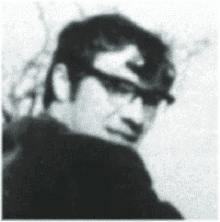
Today, many Witches use their Stang as a tool for soul-flight. When traversing the spirit worlds, I’ll often hold my Stang in hand or place it under my knees. The Stang then becomes my stead, carrying me over the hedge. In this capacity, I’ve often heard the Stang referred to as a “Bune Wand.”
Supposedly Scottish in origin, Doreen Valiente describes the Bune Wand as any object Witches use to fly*. While this doesn’t necessarily exclude a forked branch, the etymology of the word is pretty specific, as simply another term for Ragwort*. In fact, Valiente further remarks that “Long-stalked plants were often believed to be Bune Wands for witches, especially such plants as grew in wild and desolate places. The yellow ragwort is one such…”*. In folklore there are many references to Witches in connection to Ragwort, such as Robert Burns’ poem Address to the Deil:
“Let warlocks grim, an’ wither’d hags,
Tell how wi’ you, on ragweed nags,
They skim the muirs an’ dizzy crags,
Wi’ wicked speed…”
However, putting the specific etymology of Bune Wand aside, we know that Witches have often been depicted flying on forked sticks. For instance, a picture in Ulrich Molitor’s De Lamiis (incidentally the first printed depiction of Witches in flight), show three animal-headed Witches taking off on a forked branch.
In regards to why Witches would use such an object for flight, it’s been suggested that the bifurcated stick is actually a cooking fork*. This would make sense as Witches were cited as using a number of household objects to fly even including things like stools and fence posts. In Hans Baldung Grien’s “Witches Sabbath” (1510), it is strongly evident that the Witches are utilizing cooking forks.
Today, Witches continue this tradition by using their Stang when partaking in spirit flight. While you could certainly use a broom or other tool (or none for that matter), I’ve found that using the forked staff gives a sense of antiquated enchantment.
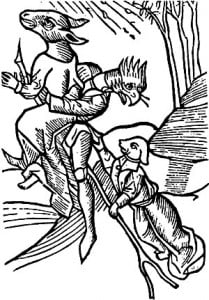
As a director of the Witch’s power, the forked staff is sometimes referred to as a “Gwelen.” According to Gemma Gary, this is a Cunning Man’s personal staff (which often features a forked top)*.
An online dictionary of Cornish language reveals to us that Gwelen translates to cane, rod, pole, stick, or wand*. Again, like the Norse “stǫng” and Scottish “Bune Wand,” there is no specification of a forked end, although it doesn’t inherently exclude the possibility either.
In terms of use, Gary notes that “It may be used to direct energy, to banish unwanted influences and spirits and conjure helpful ones. It is used to mark out and conjure the working circle and stood in the ground it forms the altar and a bridge between the worlds”*.
Although we can see a bit of overlap with Cochrane’s Stang, Gary specifies that they are not the same*.The main difference being that Gwelen serves an operative function while the Stang serves as a tool of ritual symbolism. Still, we see modern practitioners combining the two into one tool, which these use indiscriminately.
In my own practice I will carry the Stang to the four directions while calling forth the spirits. When I’m done with my invocations, I’ll place the Stang in the North of the circle (where I began). This symbolically connects the four directions and the three realms (upper, mid, and lower). It then takes on the task of acting as a bridge between the worlds, connecting me with my Gods.
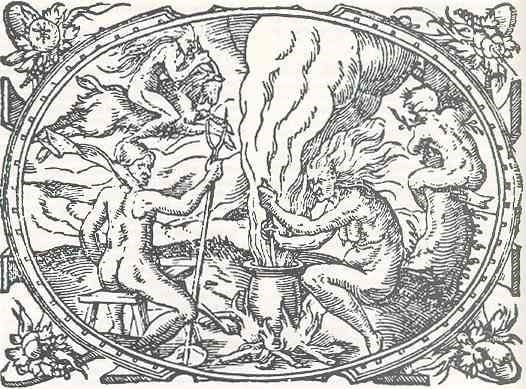
In sum, I believe that the Stang is a tool whose history is both relatively recent and old at the same time. In terms of key characteristics and name, the Stang seems to have been created by Robert Cochrane. However, as we’ve seen forked staffs have long been favored by Witches.
I think that over time, modern Witches have found that the Stang can serve many functions often ascribed to other tools (or in this case staffs). By combining the present (Robert Cochrane’s Stang) with the past (the Bune Wand and Gwelen), Witches have created a multidimensional tool.
I’m sure a lot of it has to do with practicality. Instead of having three different staffs, it’s much easier to have one (especially in terms of transportation and storage). I also find that by having one tool that serves different purposes I use it more often, essentially connecting deeper and forming a stronger bond.
So, while there doesn’t appear to be an unbroken lineage connecting the Stang to Witches of old, it has absorbed elements of the past that give it a timeless feel. We may never know exactly how the Stang came to be but today whether it’s used to represent the Horned One, to aid in spirit flight, and/or to direct energy the Stang’s effectiveness has proven to be unquestionable.
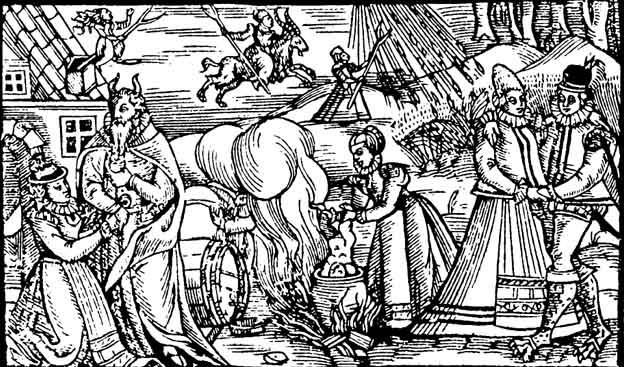
*References: In the order of which they appear.
Evan John Jones, ‘The Witches Stang’ in The Roebuck in the Thicket (2001), pg. 69-75
James Baker, ‘White Witches: Historic Fact and Romantic Fantasy’ in Magical Religion and Modern Witchcraft (1996), pg. 187
Ronald Hutton, Triumph of the Moon (1999), pg. 315
Arkon Daraul, A History of Secret Societies (1962), pg. 168-169
https://en.wiktionary.org/wiki/stang
John Brand, Observations on Popular Antiquities Vol. 2 (1841), pg. 118-119
sarahannelawless.com/2010/03/10/on-staves/
Doreen Valiente, An ABC of Witchcraft (1973), pg. 50
John Jamieson, An Etymological Dictionary of the Scottish Language (1818), pg. 11
Doreen Valiente, An ABC of Witchcraft (1973), pg. 50
Julian Goodare, The European Witch-Hunt (2016), pg. 129
Gemma Gary, A Cornish Book of Ways (2008), pg. 74-75
http://www.cornishdictionary.org.uk/cornish/gwelen
Gemma Gary, A Cornish Book of Ways (2008), pg. 74-75
Gemma Gary, The Devil’s Dozen (2015), pg. 49-54









